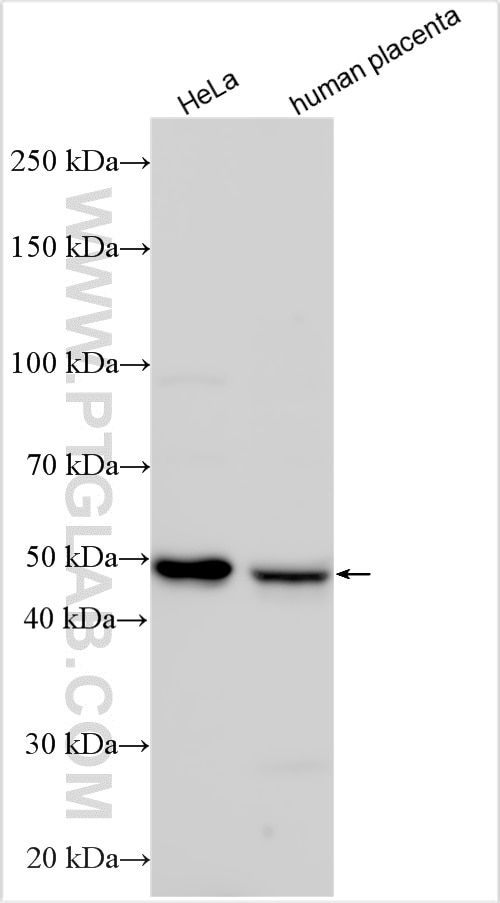Validation Data Gallery
Tested Applications
| Positive WB detected in | HeLa cells, human placenta tissue |
Recommended dilution
| Application | Dilution |
|---|---|
| Western Blot (WB) | WB : 1:2000-1:12000 |
| It is recommended that this reagent should be titrated in each testing system to obtain optimal results. | |
| Sample-dependent, Check data in validation data gallery. | |
Product Information
20851-1-AP targets GRINA in WB, ELISA applications and shows reactivity with human samples.
| Tested Reactivity | human |
| Host / Isotype | Rabbit / IgG |
| Class | Polyclonal |
| Type | Antibody |
| Immunogen | GRINA fusion protein Ag14716 相同性解析による交差性が予測される生物種 |
| Full Name | glutamate receptor, ionotropic, N-methyl D-aspartate-associated protein 1 (glutamate binding) |
| Calculated molecular weight | 371 aa, 41 kDa |
| Observed molecular weight | 49 kDa |
| GenBank accession number | BC041788 |
| Gene Symbol | GRINA |
| Gene ID (NCBI) | 2907 |
| Conjugate | Unconjugated |
| Form | Liquid |
| Purification Method | Antigen affinity purification |
| UNIPROT ID | Q7Z429 |
| Storage Buffer | PBS with 0.02% sodium azide and 50% glycerol , pH 7.3 |
| Storage Conditions | Store at -20°C. Stable for one year after shipment. Aliquoting is unnecessary for -20oC storage. |
Background Information
Glutamate Receptor Ionotropic NMDA-Associated Protein 1 (GRINA, also known as TMBIM3) is a transmembrane protein involved in calcium homeostasis and cell survival. It plays a crucial role in regulating intracellular calcium levels, which are essential for processes such as cell survival, neurotransmitter release, and apoptosis (PMID: 32124700). GRINA also involves vesicle transport and sorting, particularly in secretory cells like neurons and mammary glands (PMID: 31426446). Additionally, GRINA has been implicated in regulating aerobic glycolysis and tumor progression in gastric cancer (PMID: 30541591).
Protocols
| Product Specific Protocols | |
|---|---|
| WB protocol for GRINA antibody 20851-1-AP | Download protocol |
| Standard Protocols | |
|---|---|
| Click here to view our Standard Protocols |
